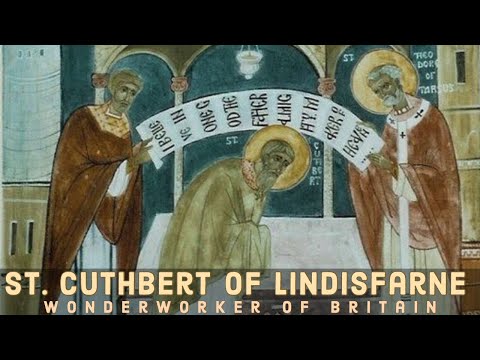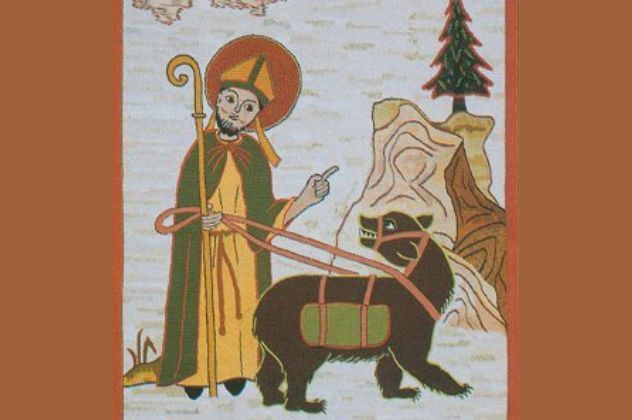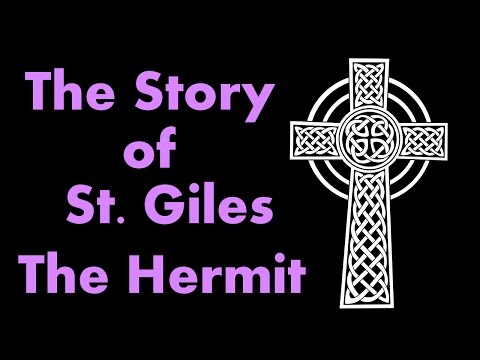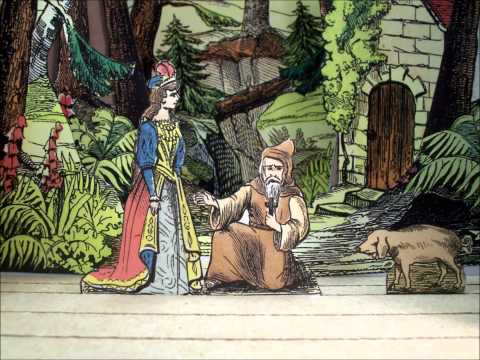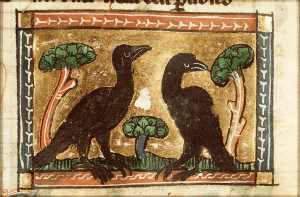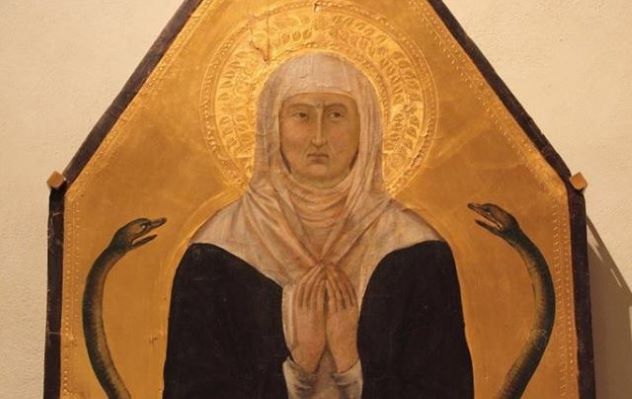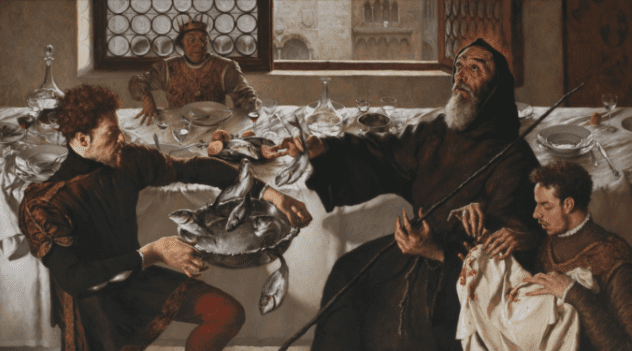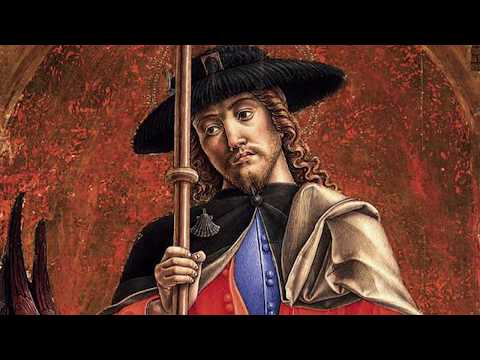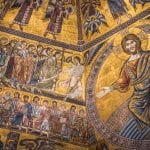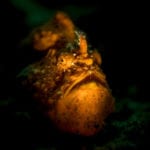Here are ten examples of saints who became famous for their animal companions. This list just features the real animals—so apologies to St. Margaret and her dragon.
10 St. Cuthbert and His Ducks
St. Cuthbert of Lindisfarne was a monk and bishop who helped spread Christianity in the northern part of England in the 7th century. Several tales are told of him with animals. Perhaps the best-known one recounts how he would pray daily while standing in the frigid waters of the North Sea. When he emerged from the waves, two otters would curl up on his feet to warm the saint. Watch this video on YouTube But there is another tale that involves ducks. In his later life, Cuthbert retired to the small island of Inner Farne to become a hermit. There, he offered his protection to the eider ducks who built their nests there. He forbade the monks of the islands to harm them in any way or even shoo them away. The ducks could be found everywhere, from hermit cells to the altar in the chapel. One monk who laughed at St. Cuthbert’s affection for the ducks was struck down by God’s anger. In Northumberland, the eider duck is still known as the Cuddy duck, after St. Cuthbert. They still nest in large numbers on Inner Farne.[1]
9 St. Corbinian and His Bear
Mules and horses can be notoriously skittish and hard to bend to your will. By all accounts, St. Corbinian’s pack horse was a good one—until a bear charged out of the woods and savaged it to death. The saint did the only thing he could do. He commanded the bear to put on the horse’s saddle and carry his goods. When the bear behaved well and carried the saint to his destination, Corbinian set the bear loose in the woods. The saddled bear became an image often associated with St. Corbinian and the German town of Freising, where he was bishop. It was also later featured in the arms of Pope Benedict XVI when he was appointed Archbishop of the region. Benedict wrote in his autobiography that “The bear with the pack, which replaced the horse or, more probably, St. Corbinian’s mule, becoming, against his will, his pack animal, was that not, and is it not an image of what I should be and of what I am?”[2]
8 St. Kevin and His Blackbird
St. Kevin of Glendalough is supposed to have been born in Ireland in AD 498 and lived for 120 years. During his long life and afterward, many legends sprang up. When he was just a baby, a white cow is said to have visited his parents’ home every morning and evening to provide the child with milk. It was while St. Kevin had retreated to his hermitage for Lent that his most famous animal relationship sprang up. Sitting still in his little hut and praying, a blackbird flew into his open hand and built a nest there. It laid its eggs and settled down to hatch them. To avoid disturbing the bird, St. Kevin stayed completely still until the chicks had hatched and fluttered away. This story was later turned into a poem by Nobel prize-winning poet Seamus Heaney. St. Kevin was not always kind, however. He is said to have drowned a woman who tried to seduce him.[3]
7 St. Giles and His Deer
St. Giles the Hermit may have lived in southern France in the 7th century, and many of the details of his life are unknown. That has not stopped stories being attributed to him over the centuries that have made him a major saint. He is usually included in the list of Fourteen Holy Helpers, saints who are particularly helpful at getting prayers done. St. Giles is said to have retreated into the forests to be completely alone in his divine contemplations. His only friend was a deer who sometimes fed the saint with her milk. One day a hunting party followed the scent of the deer into the woods and chased her to the saint’s retreat. There they fired arrows at the animal, but St. Giles was either accidentally hit or willingly got in the way of the arrow. The king who led the hunting party was so impressed by the saint’s humility that he founded a monastery for Giles.[4]
6 St. Anthony the Great and His Pig
St. Anthony of Egypt, also known as St. Anthony the Great, was hugely important in the development of Christianity. He was one of the Desert Fathers who were Christians that retreated into the wilderness to better practice their faith. St. Anthony is sometimes called the Father of All Monks. But cutting yourself off from other humans does not mean you have to be completely alone. In the desert, St. Anthony found a number of animals to keep him company—the most famous of which was a pig. Many images of the saint show him with a pig nearby. Some say the pig represents a demon in pig form that came to torment the saint, but another nicer version exists. This says that the pig was healed of a disease by St. Anthony, and afterward, it came to the saint to remind him of when it was time to pray. In later centuries, pigs were sometimes taken to church on St. Anthony’s feast day to be blessed. The smallest piglet of a litter was called the Tantony pig, after St. Anthony, because they were sometimes specially cared for and would follow their owner around like St. Anthony’s own porcine friend.[5]
5 St. Meinrad and His Ravens
St. Meinrad of Einsiedeln was a monk who lived in Switzerland in the 9th century. When he was given a statue of the Virgin Mary that could work miracles, many visitors flocked to visit him in his hermitage. Birds also flocked to him, in particular a pair of ravens. St. Meinrad was very strict in following the rules of poverty that monks were supposed to hold. Any gifts that were presented to him by guests he gave away to the poor. This proved to be his undoing when two robbers named Richard and Peter came to steal the gifts they thought Meinrad was hoarding. Finding the saint had nothing, they killed him in their anger and fled. But not before the ravens saw what they had done. The ravens, who Meinrad had cared for from chicks, followed the murders and dive-bombed them with horrible shrieks. When local people found out the saint was slain, they soon worked out who the culprits were.[6]
4 St. Veridiana and Her Snakes
Asceticism became one of the most prized virtues in Christianity in the Middle Ages. People of a holy disposition would starve themselves, live alone in the wild, and give away all they had to prove that the things of this world meant nothing to them. Some would even have themselves walled up in small chambers where they could do nothing but pray. St. Veridiana was one of these Anchorites. St. Veridiana’s cell was only 10 feet long and three feet wide (3m x 1m). A small window faced into a church so she could hear mass, and another hole allowed food to be handed in. For the next 34 years, Veridiana stayed there completely alone. Alone that is apart from a pair of large snakes. These snakes crept into the cell, and St. Veridiana would feed them with some of her own meager rations.[7]
3 St. Francis of Paola and His Trout
Of all Christian saints, there is none so closely associated with animals than St. Francis of Assisi. But other saints Francis also had animal companions. Perhaps the most unusual relationship was the one between St. Francis of Paola and a trout. Trout are not usually regarded as the most affectionate of animals, but St. Francis apparently deeply loved his fish, which he named Antonella. One day, a priest happened to see Antonella swimming happily in its pool and, thinking it was any other fish, picked it up and took it home for dinner. When St. Francis found Antonella was missing, he sent people out to find her. When someone found the priest about to eat the fish, they told the priest what he had done. The priest was annoyed that he was being bothered about a simple fish and threw his dinner on the floor in anger. The servant gathered up the shattered pieces of Antonella and took them back to Francis. St. Francis turned his eyes to heaven and prayed, “Antonella, in the name of Charity, return to life.” At once, the fish was healed and was returned to its pond as if it had not just been fried and broken.[8]
2 St. John Bosco and His Dog
Most tales of saints and animals belong to the distant past, where no accurate histories were being set down. St. John Bosco lived in the 19th century in Italy, and his life is fairly well documented. He spent his time trying to help those who had been left behind by urbanization, the poor and homeless who congregated in cities. Not everyone was pleased by John Bosco’s crusade to help the poor. His life was threatened several times. But every time he was placed in danger, a large grey dog, which the saint called Grigio, was said to appear by his side. When a gang of thugs “surrounded Don Bosco with raised sticks, the faithful Grigio appeared, beside his protégé, snarling and springing about in such fury that the wretches terrified besought Don Bosco to quiet the dog and vanished in the darkness.” Where the dog came from and where it went were apparently never known.[9]
1 St. Roch and His Medical Dog
St. Roch is a saint said to have lived in the 14th century. He became the go-to saint for those wanting protection from the plague, but he is also the patron saint of dogs. When you read his story, it is easy to see why. As a young man, St. Roch had given away all his possessions and traveled the countryside as a monk, offering prayers for those who needed them. One day, he entered a town sorely beset with the Black Death. He showed a strong resistance to catching the disease, and his prayers were effective in healing the sick. But his luck ran out. St. Roch developed the buboes and swellings of the Black Death in his leg. It was then that God sent a canine companion to ease his woes. The dog that came to St. Roch brought him bread and water to sustain him through his illness. The dog also licked the wounds that were opening on the saint’s body. The licking of the sores helped to soothe the saint’s pain. The dog’s owner followed him one day and was led to the saint. The owner helped care for St. Roch and spread the word of his holiness far and wide. The dog was declared to be a very good boy.[10]
